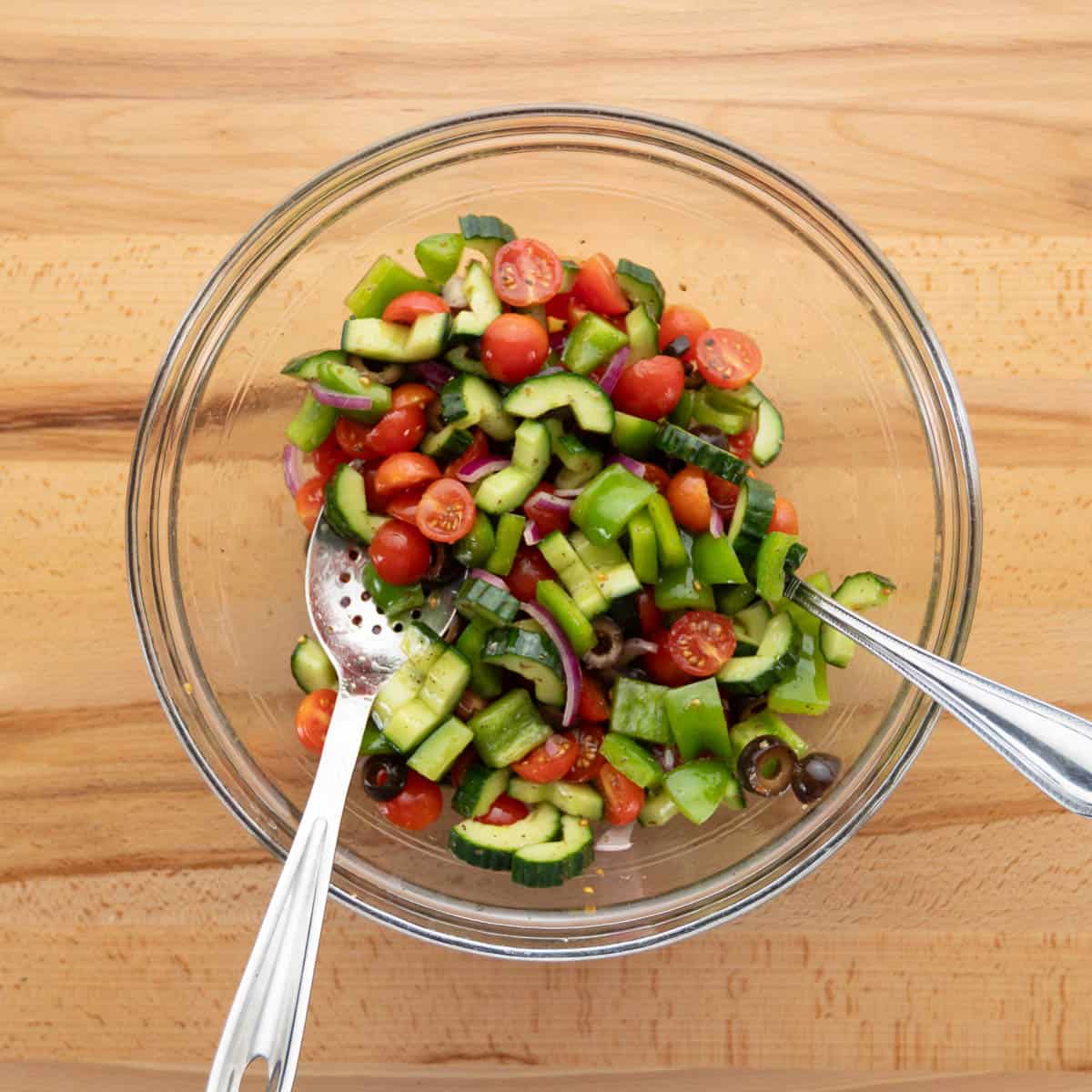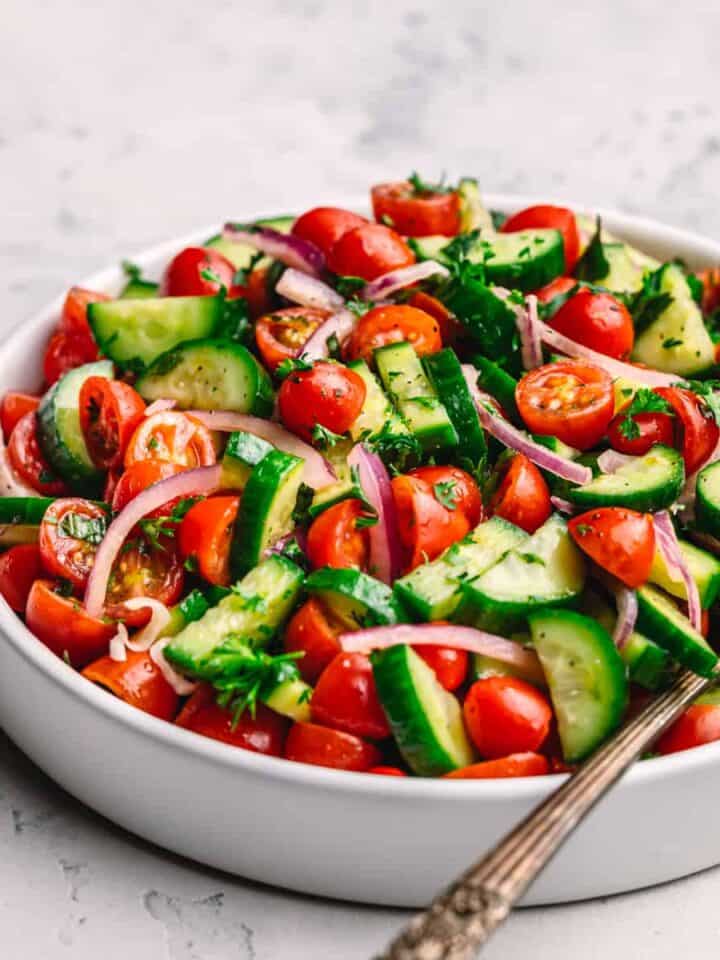Looking for a fresh and vibrant dish that's both simple and delicious? Our easy Greek salad is perfect for you! This classic Greek salad recipe, also known as Horiatiki features a delightful mix of colorful vegetables and a dressing so straightforward that it lets the veggies truly shine. Whether you're serving it as a quick lunch or as a refreshing side to your favorite protein, this salad is a go-to option that's both satisfying and healthy.

Today, I'll share a simple way to prepare Greek salad that's both healthy and refreshing. I'll list the ingredients and provide tips on how to make it taste delicious every time, tailored to your liking.
This salad pairs perfectly with shawarma chicken, chicken and saffron rice, or this Mediterranean chicken roast with veggies.
Jump to:
What is Greek Salad:
Greek salad, also known as Horiatiki, is a traditional Mediterranean dish featuring a refreshing mix of fresh vegetables, olives, and feta cheese. This classic salad is typically dressed with a simple combination of olive oil and herbs, though some recipes include vinegar or lemon juice for added acidity, while others do not.
In this recipe, we use only olive oil and oregano for the dressing, eliminating the need for vinegar or lemon juice. The natural sweetness and tanginess of the vegetables bring a delightful balance of flavors, making each bite perfectly fresh and satisfying.

Ingredients:
To make this Greek salad, you'll need to gather a few key ingredients, each playing a specific role in creating its vibrant flavor profile.

- Cherry Tomatoes: These add a burst of juiciness and a touch of sweetness.
- English Cucumber: Provides a crisp, refreshing crunch.
- Red Onion: Offers a mild sharpness and adds depth to the salad.
- Green Bell Pepper: Contributes a subtle bitterness and a pop of color.
- Kalamata Olives: Infuse a briny richness and classic Mediterranean flavor.
- Brined Feta Cheese: Adds a creamy, tangy contrast to the vegetables.
- Salt and Black Pepper: Enhances all the flavors and brings out the best in each ingredient.
- Oregano: Gives a hint of earthy, aromatic Greek flavor.
- Olive Oil: Binds everything together with its rich, smooth texture and adds a fruity note.

How to Make a Traditional Greek Salad:
Making Greek salad is quick and straightforward, taking just about 15 minutes to prepare. Here's how you can put it together:

Combine the Veggies
In a large bowl, mix together the cucumber, red onion, green bell pepper, and Kalamata olives. This creates the fresh, crunchy base of your salad.

Add the Oil and Seasoning
Drizzle the mixture with olive oil and sprinkle with half of the oregano. Season with salt and black pepper to taste. Toss everything together until the vegetables are well coated and the flavors are evenly distributed.

Add Feta Cheese and Serve.
Add feta cheese and toss lightly. Sprinkle with the remaining oregano and serve.
With these simple steps, you'll have a delicious Greek salad ready to enjoy in no time!
Tips for Making the Perfect Greek Salad:
By following these tips, you'll elevate your Greek salad, making it a standout dish that's both fresh and perfectly balanced.
- Use the Best Quality Fresh Ingredients: The key to an outstanding Greek salad lies in the quality of your ingredients. Opt for the freshest vegetables you can find, particularly the tomatoes. Sweet, juicy tomatoes with good acidity will enhance the salad's natural flavor, often eliminating the need for additional vinegar or lemon juice.
- Adjust for Acidity: While many Greek salads are made without added vinegar or lemon juice, some people prefer a bit more acidity. If you enjoy a tangy touch or if you're including lettuce in your salad, feel free to add a splash of red wine vinegar or a squeeze of lemon juice. This will add brightness and balance to the flavors.
- Use Brined Feta Cheese: For an authentic Greek salad, use brined feta cheese. It adds a creamy texture and tangy flavor that's crucial to the salad's classic taste. If you use feta that's not brined, it might not provide the same depth of flavor and moisture.
- Prep Ingredients Properly: To ensure a well-balanced salad, cut the vegetables into uniform pieces. For a crispier cucumber, be sure to remove the seeds before slicing. This prevents the salad from becoming watery and maintains a better texture.
- Season Well: Don't skip the seasoning. Properly seasoning with salt and black pepper is crucial as it enhances the natural flavors of the vegetables and cheese.
- Let It Rest: For the best flavor, let the salad sit for a few minutes after mixing. This allows the ingredients to marinate and meld together, resulting in a more flavorful dish.

Storage:
Greek salad is best enjoyed fresh, but it can be stored in the refrigerator for up to 2 days. Keep the salad and dressing separate until ready to serve to prevent the vegetables from becoming soggy.
For additional food safety guidance, please visit this website.

FAQs:
Yes, you can use different types of tomatoes. Cherry tomatoes or grape tomatoes are often used for their sweetness and juiciness. However, you can also use regular tomatoes or even heirloom varieties. Just make sure they are ripe and flavorful.
English cucumbers are ideal for Greek salad because they have a thinner skin and fewer seeds, which makes them less watery. If you use regular cucumbers, be sure to remove the seeds before slicing to keep the salad crisp.
Feta cheese is traditional in Greek salad and offers a distinctive tangy flavor. However, if you prefer, you can substitute it with other cheeses like goat cheese or a mild white cheese, though it will alter the flavor profile of the salad.
Greek salad is best enjoyed fresh, but you can prepare the vegetables and cheese ahead of time. Store them separately in airtight containers in the refrigerator. Combine them with the dressing just before serving to maintain the salad's freshness and crunch.
Absolutely! You can customize your Greek salad with additional ingredients such as capers, artichoke hearts, or even grilled chicken for added protein. Just be sure to maintain the balance of flavors.
Kalamata olives are a traditional ingredient in Greek salad, adding a briny flavor. If you don't like olives or don't have them on hand, you can omit them or use a different type of olive, but it will change the traditional taste.
If you prefer a more acidic dressing, add a splash of red wine vinegar or a squeeze of lemon juice to the olive oil and oregano. This will give the salad an extra layer of tanginess.
While traditional Greek salad doesn't include lettuce, you can certainly add it if you prefer. Just keep in mind that lettuce will wilt faster when mixed with the dressing, so it's best to add it right before serving.
Greek salad is versatile and pairs well with many dishes. Serve it alongside grilled meats, seafood, or as part of a Mediterranean spread with pita bread, hummus, and tzatziki. It also makes a great light lunch on its own.

I hope you'll enjoy this recipe and share it with friends! If you try it and don't mind, please leave me a comment and/or give this recipe a ★★★★★ rating. Be sure to subscribe to receive weekly recipes and follow me on Pinterest.
📖 Recipe
Greek Salad (Horiatiki)
Ingredients
- 1 (12 oz) English cucumber, (seeded and sliced ¼-inch thick)
- 10 oz cherry tomatoes, (halved)
- 1 (5 oz) green bell pepper, (diced)
- 2 oz sliced Kalamata olives
- 2 oz sliced red onion
- ½ teaspoon coarse kosher salt, (more or less to your liking)
- ¼ teaspoon black pepper
- ¼ cup extra virgin olive oil
- 1½ teaspoons dried oregano, (crumbled with your hands)
- 6 oz feta cheese chunk , (cut into ½-inch thick)
Instructions
- In a large bowl, mix together the cucumber, tomatoes, red onion, green bell pepper, and Kalamata olives.
- Drizzle with olive oil, sprinkle with half of the oregano, and season with salt and black pepper. Toss until the vegetables are well coated. Add feta cheese and toss lightly. Sprinkle with the remaining oregano and serve.



















Rika says
This is my go-to salad that pairs perfectly with any main dish. It’s incredibly refreshing, easy to make, and packed with flavor.